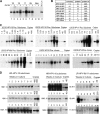Development of a cellular assay system to study the genome replication of high- and low-risk mucosal and cutaneous human papillomaviruses
- PMID: 21248030
- PMCID: PMC3067845
- DOI: 10.1128/JVI.01985-10
Development of a cellular assay system to study the genome replication of high- and low-risk mucosal and cutaneous human papillomaviruses
Abstract
We found that recircularized high-risk (type 16 and 18) and low-risk mucosal (type 6b and 11) and cutaneous (type 5 and 8) human papillomavirus (HPV) genomes replicate readily when delivered into U2OS cells by electroporation. The replication efficiency is dependent on the amount of input HPV DNA and can be followed for more than 3 weeks in proliferating cell culture without selection. Cotransfection of recircularized HPV genomes with a linear G418 resistance marker plasmid has allowed subcloning of cell lines, which, in a majority of cases, carry multicopy episomal HPV DNA. Analysis of the HPV DNA status in these established cell lines showed that HPV genomes exist in these cells as stable extrachromosomal oligomers. When the cell lines were cultivated as confluent cultures, a 3- to 10-fold amplification of the HPV genomes per cell was induced. Two-dimensional (2D) agarose gel electrophoresis confirmed amplification of mono- and oligomeric HPV genomes in these confluent cell cultures. Amplification occurred as a result of the initiation of semiconservative two-dimensional replication from one active origin in the HPV oligomer. Our data suggest that the system described here might be a valuable, cost-effective, and efficient tool for use in HPV DNA replication studies, as well as for the design of cell-based assays to identify potential inhibitors of all stages of HPV genome replication.
Figures





Similar articles
-
Development of Keratinocyte Cell Lines Containing Extrachromosomal Human Papillomavirus Genomes.Curr Protoc. 2021 Sep;1(9):e235. doi: 10.1002/cpz1.235. Curr Protoc. 2021. PMID: 34496149 Free PMC article.
-
In vitro synthesis of oncogenic human papillomaviruses requires episomal genomes for differentiation-dependent late expression.Proc Natl Acad Sci U S A. 1996 Apr 2;93(7):3062-7. doi: 10.1073/pnas.93.7.3062. Proc Natl Acad Sci U S A. 1996. PMID: 8610168 Free PMC article.
-
Metagenomic Discovery of 83 New Human Papillomavirus Types in Patients with Immunodeficiency.mSphere. 2018 Dec 12;3(6):e00645-18. doi: 10.1128/mSphereDirect.00645-18. mSphere. 2018. PMID: 30541782 Free PMC article.
-
The natural history of human papillomavirus infections of the mucosal epithelia.APMIS. 2010 Jun;118(6-7):422-49. doi: 10.1111/j.1600-0463.2010.02625.x. APMIS. 2010. PMID: 20553526 Review.
-
Why Human Papillomaviruses Activate the DNA Damage Response (DDR) and How Cellular and Viral Replication Persists in the Presence of DDR Signaling.Viruses. 2017 Sep 21;9(10):268. doi: 10.3390/v9100268. Viruses. 2017. PMID: 28934154 Free PMC article. Review.
Cited by
-
E2 protein is the major determinant of specificity at the human papillomavirus origin of replication.PLoS One. 2019 Oct 23;14(10):e0224334. doi: 10.1371/journal.pone.0224334. eCollection 2019. PLoS One. 2019. PMID: 31644607 Free PMC article.
-
The molecular biology and HPV drug responsiveness of cynomolgus macaque papillomaviruses support their use in the development of a relevant in vivo model for antiviral drug testing.PLoS One. 2019 Jan 25;14(1):e0211235. doi: 10.1371/journal.pone.0211235. eCollection 2019. PLoS One. 2019. PMID: 30682126 Free PMC article.
-
Analysis of the Replication Mechanisms of the Human Papillomavirus Genomes.Front Microbiol. 2021 Oct 18;12:738125. doi: 10.3389/fmicb.2021.738125. eCollection 2021. Front Microbiol. 2021. PMID: 34733254 Free PMC article.
-
Initial amplification of the HPV18 genome proceeds via two distinct replication mechanisms.Sci Rep. 2015 Nov 2;5:15952. doi: 10.1038/srep15952. Sci Rep. 2015. PMID: 26522968 Free PMC article.
-
Targeting papillomavirus infections: high-throughput screening reveals an effective inhibitor of cutaneous β-HPV types.J Virol. 2025 Aug 19;99(8):e0091825. doi: 10.1128/jvi.00918-25. Epub 2025 Jul 8. J Virol. 2025. PMID: 40626718 Free PMC article.
References
-
- Aaltonen, L. M., T. Wahlstrom, H. Rihkanen, and A. Vaheri. 1998. A novel method to culture laryngeal human papillomavirus-positive epithelial cells produces papilloma-type cytology on collagen rafts. Eur. J. Cancer 34:1111-1116. - PubMed
-
- Andrei, G., S. Duraffour, J. Van den Oord, and R. Snoeck. 2010. Epithelial raft cultures for investigations of virus growth, pathogenesis and efficacy of antiviral agents. Antiviral Res. 85:431-449. - PubMed
Publication types
MeSH terms
Substances
LinkOut - more resources
Full Text Sources
Other Literature Sources

